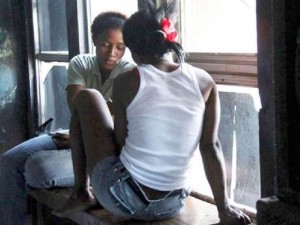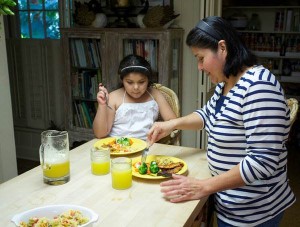LOL
http://youtu.be/CwwxLLQ4Y-I
BLOWN THE F…….AWAY
Get More:
True Life, Full Episodes
YOUNG AND LOVELESS
This is the second in a series of stories for Child Month, focusing on some of Jamaica’s most vulnerable adolescents and young people. All names have been changed for confidentiality.
Theresa speaks with her eyes. They dance in tandem with her hands as she talks about the future she wants. Her eyes look away wistfully as she searches for memories of a mother she never knew. And they become entirely flat with images of the life she leads at night.
Theresa has sex with men in exchange for money. She is 17.
“I didn’t want to do it when I was just starting,” she says of her first encounter, one year ago.
“I was wondering, ‘Why am I doing this?’ It never felt right, but I had to get a food.”
At the time, Theresa had recently dropped out of school and had given birth to a daughter.
She went through a harrowing experience in a children’s home before returning to her household.
The expectation of her family was made clear: she had a child to take care of so she had to go out and make a living.
Saddled with adult responsibilities and unarmed – without an education or employable skill – Theresa took the advice of an older friend, who was already involved in prostitution, to make money through sex.
Like scores of other teen moms without a marketable skill, prostitution became a means of survival.
It was a decision, she told herself, for her own survival – and above that, for the survival of her infant daughter.
For three to four days each week, Theresa would leave her daughter with a relative while she hit the streets at 7 p.m. working – selling the most valuable thing she possessed, her body, until 4 a.m.
This allowed her to earn between $4,000 and $5,000 each day to meet the needs of her daughter and herself.
Theresa has never been proud of her choices and many of her family members are not aware that this young, diligent mother by day is a street girl by night.
The members of her family who know of her prostitution do not openly admonish her, but she knows, they do not approve.
Her job is also hidden from two key people in her life – her daughter and her boyfriend.
MORE SELF-AWARE
After a year on the streets, Theresa remains soft-spoken, but firm in her convictions to forge ahead. She is far more self-aware now than the younger misguided version of herself.
Cradling her chin with one hand, she reflects on the course her life could have taken.
“I feel like if I had my mom around, I would not have gotten pregnant,” she says. “I didn’t have a mommy to hug me up and talk to me and make me feel special. I didn’t have that kind of love. So I started to search for it.”
Theresa looked all over for love.
In the absence of her mother, who died when she was very young, and her father, who worked out of town, Theresa tried to form a relationship with her stepmother.
They did not get along and the teenager was beaten, violently and repeatedly.
“I would rather stay in school. [I would] rather have an understanding relationship with my stepmother and the people who made me feel appreciated and happy,” said Theresa, reflecting on a life hardened with the realities that face so many young girls in Jamaica.
“My first exposure to sex was in grade eight, when I was 13,” she recalls. The boy was 18.
“I loved him, but he didn’t love me. I got hurt. After that, I just went from man to man.” The loveless pattern of her young life continued when she got pregnant and sought prenatal care.
“At the health centre, they treat you like nobody. The nurses cuss me, and keep asking ‘Why you put yourself in this situation?’ They made me feel so embarrassed and left out.”
Theresa wants young mothers to get a more gentle response from health-care workers.
“They should be more caring, make us feel like somebody. They could say, ‘We know you made a mistake, but you don’t have to get here again’.”
SEARCHING FOR SENSE OF VALUE
While Theresa knows that love will never come from the men who pay her for sex, she still longs for an elusive sense of value.
“The worst thing is the way the men look at you, like you are nothing. I see nice women, all dressed up, and I wonder if I am able to have a normal life like that.”
According to Theresa, she has been threatened but never physically harmed.
“It’s very scary because you never know what’s coming and who you are dealing with.
“Lots of times the men don’t want to use condoms, but I have to use them. I don’t want to die.”
Older prostitutes have reported instances where their clients “beat them up” and take back the money after paying.
In one case in the Corporate Area, the prostitute had her throat cut by a client. She died in the abandoned lot where she had sold her sexual favours.
Faced with these possibilities, Theresa is determined to define a new norm for herself.
REFUGE
She has found refuge and support through the National HIV/STI Programme (NHP) of the Ministry of Health.
The NHP, one of a range of services offered by the health ministry for teenagers in trouble, funds a second-chance education programme in which Theresa is enrolled.
“You know when you have friends and you can really talk to them?” Theresa asks with a wide grin, referring to one of the NHP outreach workers with whom she has become close.
“She makes me feel appreciated. Sometimes when I feel down, she says, ‘Just keep working towards what you want’.”
Theresa also credits her strong will to her one-year-old daughter. “I want it to be different for her,” she says. “I want her to have everything she needs, because I didn’t have that. I have to be a role model, set an example and make her look up to me.”
Her determination to prevent her daughter from having to move into a life of prostitution is a driving force for Theresa.
Data from the latest National Knowledge, Attitudes, Behaviours and Practices Survey indicate that participation in sex for favours or money (transactional sex) increased in the 15-24 age group from 39 per cent in 2008 to 43 per cent in 2012.
Females ages 10-19 are almost three times more likely to be infected with HIV than boys of the same age.
Almost 18 years into her life, Theresa may be damaged, but she is hardly broken. Her resilience shines when she talks about her plans to go back to school. “This is just a stepping stone to further me,” she says with dazzling eyes. “I am going to make it.”
The Gleaner is presenting this series in partnership with UNICEF Jamaica which addresses several challenges facing HIV+ adolescents and young women through its Adolescent Health and Empowerment programme.
Working closely with the Ministry of Health and other partners, UNICEF advocates for the provision of more adolescent-friendly policies and services to reduce vulnerability and infection rates among young populations.
UNICEF also supports the provision of school-based sexual and reproductive health education, and programmes by government agencies and NGOs that seek to provide care and treatment for most at-risk populations.
To talk about the ‘We Matter Too’ Child Month series online, follow UNICEF on Twitter: @UNICEF_Jamaica and join the conversation using the #WeMatterToo hashtag; like UNICEF Jamaica on Facebook; visit the website: http://www.unicef.org/jamaica
THE HEALTH TOLL OF IMMIGRATION
The Health Toll of Immigration
J. Michael Short for The New York Times
Esther Angeles, 41, with her daughter, Johanna Marisol Gomez, 7. Ms. Angeles has developed diabetes since coming to the United States and struggles to see that her daughter eats healthfully.
By SABRINA TAVERNISE
Published: May 18, 2013 74 Comments
BROWNSVILLE, Tex. — Becoming an American can be bad for your health.
Readers’ Comments
Share your thoughts.
Post a Comment »
Read All Comments (35) »
A growing body of mortality research on immigrants has shown that the longer they live in this country, the worse their rates of heart disease, high blood pressure and diabetes. And while their American-born children may have more money, they tend to live shorter lives than the parents.
The pattern goes against any notion that moving to America improves every aspect of life. It also demonstrates that at least in terms of health, worries about assimilation for the country’s 11 million illegal immigrants are mistaken. In fact, it is happening all too quickly.
“There’s something about life in the United States that is not conducive to good health across generations,” said Robert A. Hummer, a social demographer at the University of Texas at Austin.
For Hispanics, now the nation’s largest immigrant group, the foreign-born live about three years longer than their American-born counterparts, several studies have found.
Why does life in the United States — despite its sophisticated health care system and high per capita wages — lead to worse health? New research is showing that the immigrant advantage wears off with the adoption of American behaviors — smoking, drinking, high-calorie diets and sedentary lifestyles.
Here in Brownsville, a worn border city studded with fast-food restaurants, immigrants say that happens slowly, almost imperceptibly. In America, foods like ham and bread that are not supposed to be sweet are. And children lose their taste for traditional Mexican foods like cactus and beans.
For the recently arrived, the quantity and accessibility of food speaks to the boundless promise of the United States. Esther Angeles remembers being amazed at the size of hamburgers — as big as dinner plates — when she first came to the United States from Mexico 15 years ago.
“I thought, this is really a country of opportunity,” she said. “Look at the size of the food!”
Fast-food fare not only tasted good, but was also a sign of success, a family treat that new earnings put in reach.
“The crispiness was delicious,” said Juan Muniz, 62, recalling his first visit to Church’s Chicken with his family in the late 1970s. “I was proud and excited to eat out. I’d tell them: ‘Let’s go eat. We can afford it now.’ ”
For others, supersize deals appealed.
“You work so hard, you want to use your money in a smart way,” said Aris Ramirez, a community health worker in Brownsville, explaining the thinking. “So when they hear ‘twice the fries for an extra 49 cents,’ people think, ‘That’s economical.’ ”
For Ms. Angeles, the excitement of big food eventually wore off, and the frantic pace of the modern American workplace took over. She found herself eating hamburgers more because they were convenient and she was busy in her 78-hour-a-week job as a housekeeper. What is more, she lost control over her daughter’s diet because, as a single mother, she was rarely with her at mealtimes.
Robert O. Valdez, a professor of family and community medicine and economics at the University of New Mexico, said, “All the things we tell people to do from a clinical perspective today — a lot of fiber and less meat — were exactly the lifestyle habits that immigrants were normally keeping.”
As early as the 1970s, researchers found that immigrants lived several years longer than American-born whites even though they tended to have less education and lower income, factors usually associated with worse health. That gap has grown since 1980. Less clear, however, was what happened to immigrants and their American-born offspring after a lifetime in the United States.
Evidence is mounting that the second generation does worse. Elizabeth Arias, a demographer at the National Center for Health Statistics, has made exploratory estimates based on data from 2007 to 2009, which show that Hispanic immigrants live 2.9 years longer than American-born Hispanics. The finding, which has not yet been published, is similar to those in earlier studies.
Still, the data does not break down by generation. Ms. Arias cautioned that subsequent generations — for example, grandchildren and great-grandchildren — may indeed improve as they rise in socioeconomic status, which in the United States is strongly correlated with better health.
Other research suggests that some of the difference has to do with variation among American-born Hispanics, most of whom still do better than the rest of the American population. Puerto Ricans born in the continental United States, for example, have some of the shortest life spans and even do worse than whites born in the United States, according to research by Professor Hummer, dragging down the numbers for American-born Hispanics. But Mexican immigrant men live about two years longer than Mexican-American men, according to the estimates by Ms. Arias.
Why is a harder question to answer, researchers say. Some point to smoking. Andrew Fenelon, a researcher at Brown University, found in 2011 that half of the three-year life expectancy advantage that Hispanic immigrants had over American-born Hispanics was because they smoked less. The children of immigrants adopt health behaviors typical of Americans in their socioeconomic group. For second-generation Hispanics, the group tends to be lower income, with higher rates of smoking and drinking.
Other researchers say culture contributes. Foreign-born Hispanics are less likely than American-born Hispanics to be raising children alone, and more likely to be part of large kinship networks that insulate them from harsh American economic realities that can lead to poor health.
“I’d love to have my wife at home taking care of the kids and making sure they eat right, but I can’t afford to,” said Camilo Garza, a 34-year-old plumber and maintenance worker whose grandfather immigrated from Mexico. “It costs money to live in the land of the free. It means both parents have to work.”
As a result, his family eats out almost every night, leaving his dining table abandoned.
“It’s a decoration,” said Mr. Garza, who is overweight and a smoker. “It’s a place where we set groceries before sticking them in the refrigerator.”
The lifestyle takes its toll. The county in which Brownsville is situated, Cameron, has some of the highest rates of obesity and diabetes in the country. The numbers are made worse by a lack of physical activity, including walking. Immigrants said they felt so conspicuous during early attempts to walk along the shoulder of the roads that they feared people would suspect they were here illegally. Ms. Angeles recalled that strolling to a dollar store provoked so many stares that she felt like “a bean in rice.”
“In Mexico, we ate healthily and didn’t even know it,” said Ms. Angeles, who has since developed diabetes. “Here, we know the food we eat is bad for us. We feel guilty. But we eat it anyway.”
Still, immigrants have better health outcomes than the American-born. A 2006 analysis by Gopal K. Singh, a researcher at the Department of Health and Human Services, and Robert A. Hiatt, a professor of epidemiology and biostatistics at the University of California, San Francisco, found that immigrants had at least a 20 percent lower overall cancer mortality rate than their American-born counterparts.
Mortality rates from heart disease were about 16 percent lower, for kidney disease 18 percent lower, and for liver cirrhosis 24 percent lower.
“When my daughter was born, my doctor told me that if I wanted to see her 15th birthday I needed to lose the weight,” said Gerry Ortiz, 37, a first-generation Mexican-American in Brownsville. He managed to lose 75 pounds, motivated in part by his grandfather, a farmer in rural Mexico who at 93 still rides his bicycle every day. He stares down at the family from a black-and-white photograph hanging in Mr. Ortiz’s living room. Four of the family’s six siblings are obese and have diabetes.
And health habits in Mexico are starting to look a lot like those in the United States. Researchers are beginning to wonder how long better numbers for the foreign-born will last. Up to 40 percent of the diet of rural Mexicans now comes from packaged foods, according to Professor Valdez.
“We are seeing a huge shift away from traditional diets,” he said. “People are no longer growing what they are eating. They are increasingly going to the market, and that market is changing.”
Joseph B. McCormick, the regional dean of the University of Texas School of Public Health in Brownsville, said, “The U.S. culture has crept across the border.”
Perhaps more immediate is the declining state of Hispanic health in the United States. Nearly twice as many Hispanic adults as non-Hispanic white adults have diabetes that has been diagnosed, a rate that researchers now say may have a genetic component, particularly in those whose ancestry is Amerindian from Central and South America, Dr. McCormick said.
Hispanic adults are also 14 percent more likely to be obese, according to 2010 data from the Centers for Disease Control and Prevention. The rate is even higher for Hispanic children, who are 51 percent more likely to be obese than non-Hispanic white children.
“We have a time bomb that’s going to go off,” said Dr. Amelie G. Ramirez, a professor of epidemiology and biostatistics at the University of Texas Health Science Center in San Antonio. “Obesity rates are increasing. Diabetes is exploding. The cultural protection Hispanics had is being eroded.”
But at least for now, the older generation is still enjoying its advantage. In the De Angeles snack bar, a favorite meeting place for elderly Brownsvillians, one regular who is 101 still walks across the bridge to Mexico. Maria De La Cruz, a 73-year-old who immigrated to the United States in her 40s, says her secret is raw garlic, cooked cactus and exercise, all habits she acquired from her father, a tailor who died at 98.
“He had very pretty legs, like mine,” she said, laughing. “You want to see them?”
A version of this article appeared in print on May 19, 2013, on page A1 of the New York edition with the headline: The Health Toll of Immigration.
SO SAD
Asia Johnson was fatally shot Saturday night May 18,2013 on an MTA bus in Queens.
The teenager was shot in the head just after 9 p.m. while riding a Q6 bus on Sutphin Boulevard in Jamaica.
Police rushed her to the hospital, where she was pronounced dead.
The NYPD says a 14-year-old girl was shot and killed on a Queens MTA bus Saturday night.
The incident happened around 8:50 p.m. on board the Q-6 bus on Sutphin and Rockaway Boulevard in the Jamaica section.
Authorities say a male began firing shots into the bus and the victim was struck in the head. She was rushed to Jamaica Hospital where she was pronounced dead.
Police have made no arrests and their investigation is still ongoing.
Anyone with information is ask
Read more: http://www.myfoxny.com/story/22290566/fatal-city-bus-shooting-in-queens#ixzz2TkIOSOzE
****RULES**** 1. Debates and rebuttals are allowed but disrespectful curse-outs will prompt immediate BAN 2. Children are never to be discussed in a negative way 3. Personal information eg. workplace, status, home address are never to be posted in comments. 4. All are welcome but please exercise discretion when posting your comments , do not say anything about someone you wouldnt like to be said about you. 5. Do not deliberately LIE on someone here or send in any information based on your own personal vendetta. 6. If your picture was taken from a prio site eg. fimiyaad etc and posted on JMG, you cannot request its removal. 7. If you dont like this forum, please do not whine and wear us out, do yourself the favor of closing the screen- Thanks! . To send in a story send your email to :- [email protected]






Recent Comments